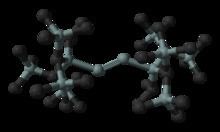 | ||
Related silyls | ||
Disilyne, Si
2H
2, is a metalloid hydride composed of silicon and hydrogen. Disilyne is not well-characterised or well-known, and it is kinetically unstable with respect to isomerisation. The most stable isomer is a dibridged singlet, named di-μH-disilyne, followed by a monobridged μH-disilyne. A third, unbridged singlet ismomer is predicted to exist before disilyne - disilenylidene.
Contents
Disilynes contain a formal silicon–silicon triple bond and as such is formulated R2Si2 (where R is a substituent group) and is the silicon analogue of an alkyne. Some chemists use the term silyne to refer to compounds containing a silicon–silicon triple bond whilst others use the term to refer to compounds containing a silicon–carbon triple bond by analogy to silene, which often refers to compounds containing silicon–carbon double bonds. The term polysilyne can refer to the layer polymer (SiH)n or substituted derivatives.
The first reported disilynes
The first example isolated and characterised by X-ray crystallography is an emerald green crystalline compound reported in 2004. This molecule has the structure:
R′2R′′Si-Si2-SiR′′R′2where R′ = HC(SiMe3)2 and R′′ = i-propylIt was prepared by the reduction of the related tetrabrominated precursor by potassium graphite (KC8), it is air and moisture sensitive and does not melt or decompose until 128 °C.
Considered as a tetrasila-2-yne derivative the four Si atoms in the chain are not collinear and in this respect the compound differs from the related alkyne. The four silicon atoms in the chain are however perfectly coplanar, the first and fourth silicon atoms are trans to one another, and the angle between the triple bond and the adjacent silicon is 137°. The central triple bond is 206 pm (around 4% shorter than Si-Si double bonds (214pm)) and the other Si-Si single bonds are 237 pm. The colour is believed to be due to a weak π - π* transition.
29Si NMR shows upfield shift 89.9 ppm relative to silyl substituted disilenes. Calculations show a bond order of 2.6. An alternative calculation of the bond order by a different group describes the bonding as essentially due to 2 electron pairs with the other pair in non-bonding orbitals.2. Reaction of this compound with phenylacetylene produced a 1,2 disilabenzene. Other workers have also reported another related compound which contains a hexasila-3-yne chain:
R3Si(SiR3)SiMeSi2SiMe(SiR3)SiR3where Me = methyl and R = t-butylIn this the Si-Si triple bond length was calculated as 207 pm.
Comparison to C-C, Ge-Ge, Sn-Sn, Pb-Pb triple bonds
Triple bonded compounds of the heavier members of group 14 have all been prepared; lead in 2000, and tin and germanium in 2002. In all of these the substituents attached to the bonded metal atoms are not collinear as in the alkynes but trans bent.
